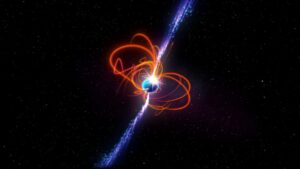
The more we look at the universe, the more we’ll be able to find rare and wonderful things.
In an attempt to see and track down more rare events, researchers have installed a special instrument called VLITE at the Very Large Array. It studies the Ionosphere and watches for transient events that change in brightness in the sky. Each year this instrument collects 6000 hours of data in the 18 antennas.
This data was recently used to try and identify a weird object spotted by a radio array in Australia. Digging through VLITE’s data, they determined the weird object is something we didn’t know could exist: a slow rotating neutron star with powerful radio emissions.
When your average star dies, it expels its atmosphere and what’s left condenses and cools over time. Larger stars – not the largest, just your really above average stars – instead explode off their outer layers and their cores collapse down into neutron stars. With the right conditions, strong magnetic fields can form, and sometimes that will mean a new born pulsar, and sometimes, somehow, some become magnetars with massive magnetic fields.
In VLITE’s data, and historical data from other systems, they found evidence that this object – cataloged as GPM J1839-10 – had been rotating every 22 minutes, emitting 5 minutes of radio waves during that orbit.
This work is published in Nature and was led by Natasha Hurley-Walker. Her fellow researcher Simona Giacintucci points out, “This enigmatic object has been hiding in the data for decades – we just did not know we had to look for it until its discovery by the Murchison Widefield Array.” Fellow researcher Tracy Clarke points out “Findings like this are exciting because they highlight the gaps in our understanding of the physics of these extreme stars known as magnetars.”
Reference:
Hurley-Walker, N., Rea, N., McSweeney, S.J. et al. A long-period radio transient active for three decades. Nature 619, 487–490 (2023). https://doi.org/10.1038/s41586-023-06202-5
